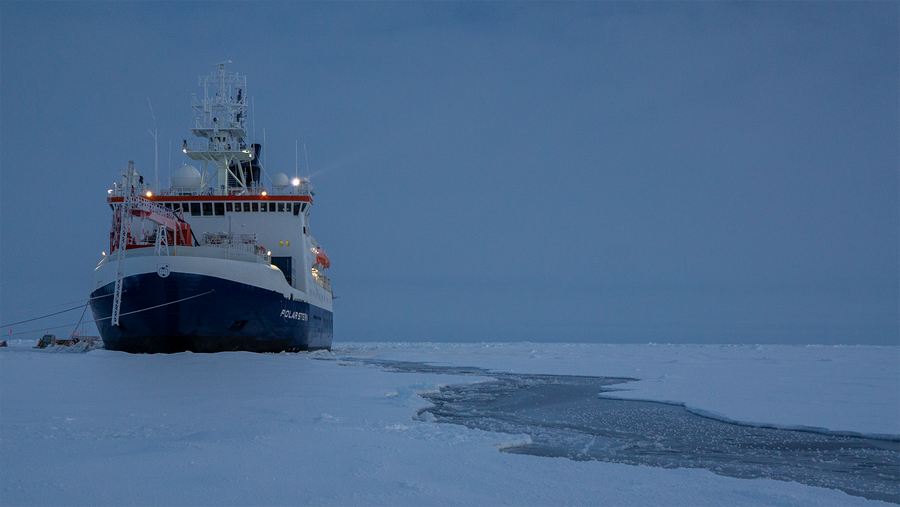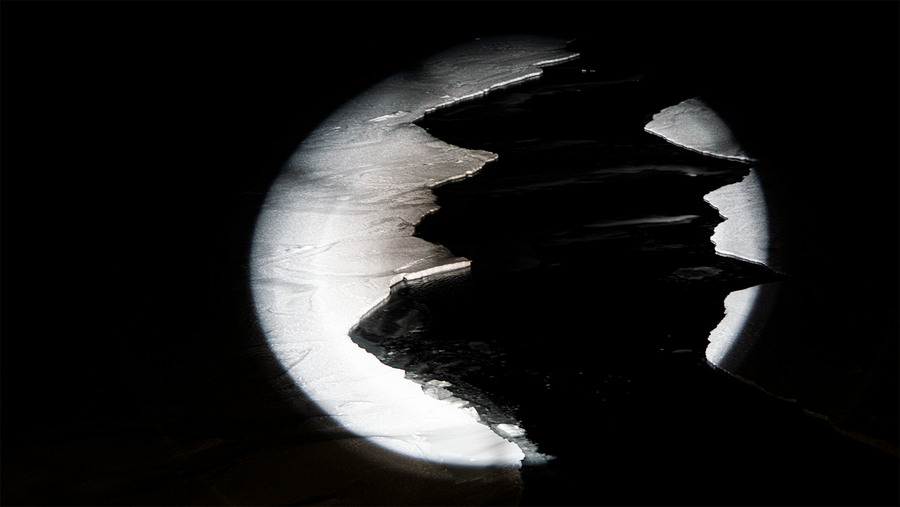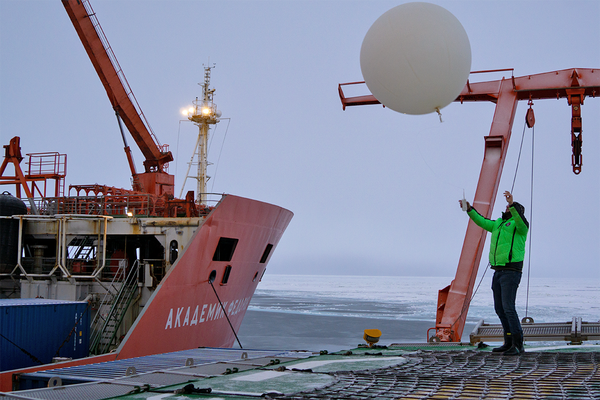With a deep breath, Sandro Dahlke releases a white weather balloon nearly as tall as himself from our ship’s deck and toward the Arctic sky. The helium-filled orb shoots upward while the radiosonde—an instrument package attached to the balloon’s tail that will monitor the weather—whips wildly in the wind. We are far north in the Arctic Ocean, onboard the German icebreaker Polarstern, and the wind immediately sweeps the balloon toward the starboard side as it rises—a worrying prospect for Dahlke. Typically, there would be few obstacles to encounter on the icy ocean. But today we are tethered to a Russian icebreaker, the Akademik Fedorov, which looms over our smaller one, and he is concerned the balloon might hit the neighboring ship.
The inflatable makes a close call, passing within centimeters of the ship’s towering crane. Once it passes freely into the air above, Dahlke, an atmospheric scientist at the Alfred Wegener Institute in Germany, walks lightheartedly across the helicopter pad (which also serves as his launchpad) and heads back toward his office. There, he will monitor the data captured by the balloon’s radiosonde—which measures temperature, humidity, wind direction and speed, air pressure and position every second as it climbs higher into the sky—until the data abruptly come to a halt: the moment the balloon bursts and falls back toward the ocean.
Dahlke’s release was part of a well-coordinated effort: Several hundreds of other balloons around the world were sent airborne at the same time so their data can be compared and incorporated into weather forecasts. But Dahlke’s balloon was sent skyward at 85 degrees north latitude and 133 degrees east longitude, hundreds of kilometers closer to the North Pole than any other. It would provide a crucial data point where there would have been none. In addition, he and his colleagues launch a balloon every six hours from the ship and will do so for an entire year—more than 1,400 voyages aloft—which will provide far more information about Arctic weather than has been available. Previous studies, based on occasional Arctic balloon releases, show the data actually improve forecasts at lower latitudes. The results will also provide a big boost to climate models, which suggest changes in the Arctic have a significant, trickle-down effect on the rest of the planet—although the connection is still being debated.
On supporting science journalism
If you're enjoying this article, consider supporting our award-winning journalism by subscribing. By purchasing a subscription you are helping to ensure the future of impactful stories about the discoveries and ideas shaping our world today.

Crack refreezes two days after it opened and headed toward the Polarstern. Credit: Shannon Hall
A primary suspect in this linkage is the so-called polar jet stream, a fast river of wind that circumnavigates the Arctic, typically keeping cold temperatures fenced in and warm ones out when it is strong. But should the jet stream weaken—an effect that can be caused by a lower temperature gradient between the Arctic and the equator as the former warms faster than the rest of the planet—the jet stream can become wavy and meander more. That means the northward peaks and southward valleys in the wavy stream, which we see on weather maps as high- and low-pressure systems, can build more often and last longer. This setup produces prolonged heat waves, stalled tropical storms and unrelenting deep freezes.
“To me, it seems so obvious that the Arctic can influence our weather,” says Judah Cohen, an atmospheric scientist at the company Atmospheric and Environmental Research, who is not onboard the Polarstern. But the topic, he says, is “controversial and contentious.”
The issue is not resolved, in large part, because the Arctic remains one of the least studied places on earth. “We don’t understand key climate processes in the central Arctic, particularly in winter and spring, when the sea ice is so thick that even the best research icebreakers are locked out of this icy region,” says Markus Rex, expedition head and an atmospheric scientist at the Alfred Wegener Institute, the lead research institution for this mission. To change that situation, Rex, Dahlke, hordes of other scientists and even a handful of lucky journalists—including me—traveled to the Arctic last month, freezing the Polarstern into the Arctic sea ice. The unique platform will allow the mission, known as the Multidisciplinary Drifting Observatory for the Study of Arctic Climate (MOSAiC), to study the Arctic system over an entire year, gathering crucial data in the winter and spring. Dahlke and his colleagues even got in a few extra data runs—sending weather balloons skyward during our northward journey from Norway. The blustery afternoon when Dahlke worried about the nearby icebreaker, for example, occurred just before we moored to the ice and the Akademik Fedorov swung by to drop off instruments, personnel and fuel. We were then left adrift in the ice mass, which slowly migrates up and over the North Pole during the winter months.

Spotlight illuminates a crack at night so that scientists can closely monitor it. Credit: Shannon Hall
The trove of data will allow scientists to better understand a number of small-scale details within the Arctic. That knowledge is vital because numerical weather and climate models have resolutions that are anything but small—instead they approach scales of a few and 100 kilometers, respectively. Yet many events happen across smaller spaces. For example, a couple of daysafter we crashed into the heart of a 3.5-kilometer-wide ice floe—a move that would hopefully entomb us within the ice for a year—a crack opened from the horizon and right toward the bow of the ship. It snaked around the port side and moved beyond the stern. In only an hour, it opened by five meters and then started to refreeze, creating a thin, black sheet that looked like an inky river flowing through the white seascape. Other cracks also popped up within the ice while I was onboard—each affecting the atmosphere by releasing heat from the comparably warm ocean below.
These kinds of local changes, when added up across the large Arctic Ocean, alter the atmosphere, yet they would never be accounted for within a climate model. Instead scientists build “parameterizations” that average these effects across a larger scale—much like a single pixel within a picture reflects only one color. But the parameterizations are often developed at midlatitudes and struggle to realistically represent the icy and often dark world of the High Arctic. Or they are developed in the Arctic but after a single campaign that took place during the summer, and they therefore cannot capture other seasons. “This is why we’re here,” Dahlke says.
To give just one example: Scientists would like to better observe an Arctic phenomenon known as the temperature inversion. At midlatitudes, the atmosphere gets colder with height. But in the Arctic, it actually gets warmer—at least in the winter. Ice and snow cool down the frozen sea surface, sometimes to temperatures so low that frostbite can strike in mere minutes. Any heat can radiate into space, especially when clouds are thin or scarce, making the higher atmosphere warmer than the surface. A temperature inversion—or lack thereof—plays a critical role in the amount of heat that is released from the Arctic or trapped up north. Yet most climate models do not re-create these inversions well, says Marion Maturilli, an atmospheric scientist at the Alfred Wegener Institute, who is coordinating the balloon measurements but is not onboard the Polarstern herself.
One of the main challenges is that temperature inversions form most often during winter, for which there are very few data. Strong storms and open cracks within the ice can similarly disrupt the inversion, causing it to weaken or disappear. The weather balloons—which will allow Dahlke and his colleagues to determine how strong the inversion might be at four different times every day—will capture unprecedented information that can be fed into climate models. “That’s where MOSAiC is going to make a big difference,” says Jennifer Francis, a climate scientist at the Woods Hole Research Center, who studies the connections between Arctic and midlatitude weather but is not on the ship. Once climate models can better represent the temperature inversion, they will better represent our warming world.
Researchers will also feed the data into large-scale maps of the temperature layers within the atmosphere, which can be used to trace the shapes of the waves of the jet stream, allowing forecasters to determine how far north and south they might meander. Data from the lowest layers of the Arctic have been missing, Francis says. “When there are no data, the models must average across those expanses, based on nearest measurements,” she explains. “Sometimes this means that important variations in the temperatures or atmospheric maps are missed.”
Dahlke and his colleagues will continue to launch a radiosonde every six hours on the dot. But bad weather could impact their work. Although the team releases the devices from the ship, it will also launch a tethered balloon from the ice, which will float up to one kilometer and remain in the skyfor several hours. As soon as we reached the floe on October 4, Dahlke and his colleagues worked hard to build the perfect site for such a balloon. They leveled the snow with shovels, added a wood foundation for a tent that would host the waiting balloon, ran electricity from the ship to the site and pulled their equipment to the ice—all between launches, of course. But they have yet to release the tethered balloon because of strong winds. In late October (a few days after I began the long journey back to Norway on the Akademik Fedorov), they hit another setback: “There was a [polar] bear carrying around our 300-kilogram tent like a shopping bag,” Dahlke tells me via WhatsApp (the best form of communication onboard the ship). Luckily, the animal only damaged the rig a bit, but the incident was a stark reminder that although it is so crucial, Arctic fieldwork is never easy.
